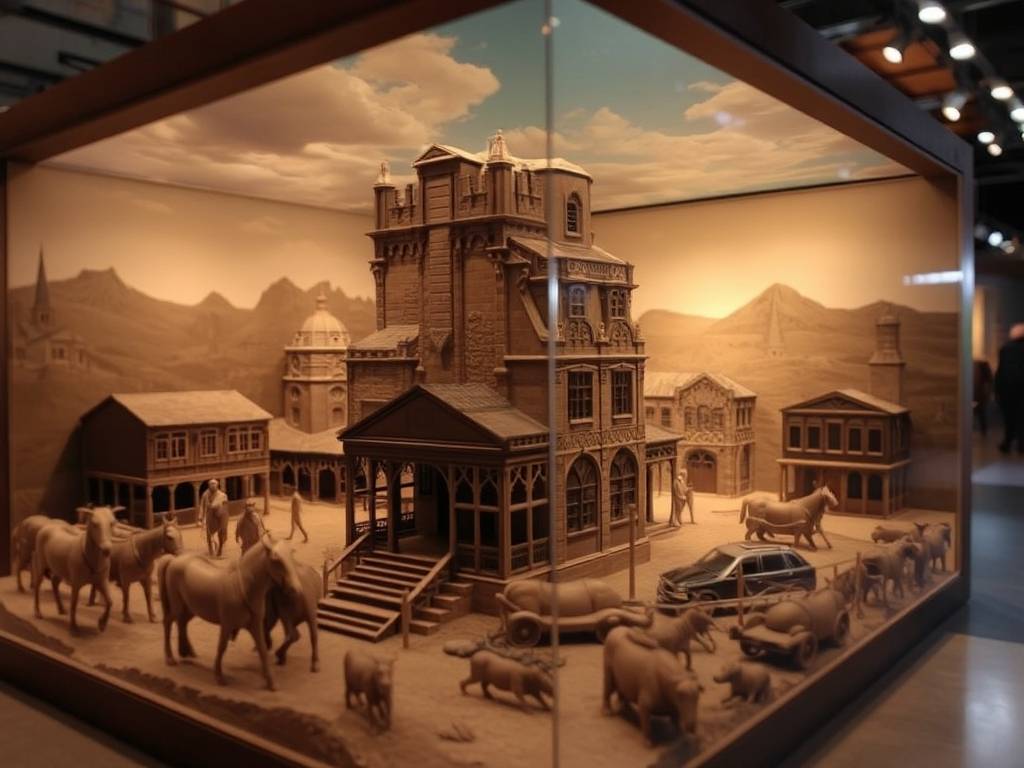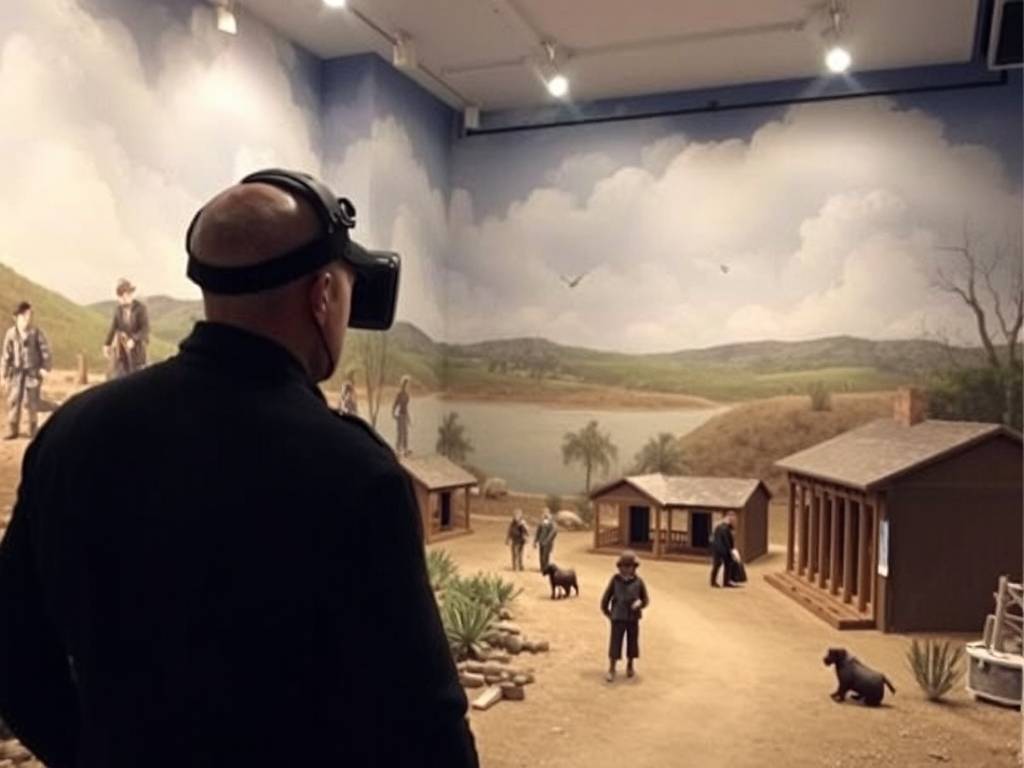Imagine standing on the deck of a ship, the salty sea spray misting your face as you gaze upon a coastline no human eyes have seen for over five centuries. You’re not just watching a documentary; you are there, present in a moment frozen in time. This is the promise and the profound experience offered by the latest expansion for the groundbreaking Diorama Museum VR platform: the "Historical Scenes Expansion." This isn't merely an update; it's a paradigm shift in how we engage with our collective past, transforming passive observation into an active, emotional journey.
For years, dioramas have been the silent storytellers of museums. Encased behind glass, these meticulously crafted miniature scenes offer a glimpse into pivotal moments—a dinosaur locked in combat, a medieval market bustling with tiny figures, a spacecraft poised on the launchpad. They are beautiful, instructive, but ultimately distant. The Diorama Museum VR app changed that by digitizing these scenes, allowing users to orbit them, zoom in, and hear ambient sounds. But the Historical Scenes Expansion shatters the glass case entirely. It doesn't just let you look at history; it invites you to step inside it.
The core innovation of this expansion lies in its approach to scale and perspective. You begin your journey in the familiar "curator's view," observing a hyper-detailed, three-dimensional diorama of, for example, the construction of the Great Pyramid of Giza. You can appreciate the grand scope, the thousands of ant-like workers toiling under the Egyptian sun. But then, with a simple gesture or voice command, you initiate the "Immersion Protocol." The world around you dissolves and reconstructs in a breathtaking transition. Suddenly, you are no longer a spectator above the scene. You are standing on the Giza plateau, the colossal stone blocks towering over you, the air thick with dust and the sounds of chiseling and shouted commands. This seamless shift from macro to micro is the expansion's magic trick, making the monumental personal and the ancient immediate.

Let's explore a few of the expansion's meticulously researched and built environments to understand its full potential. One of the flagship scenes is "Viking Voyage: Landing at Vinland." In the curator's view, you see the iconic longship, the knarr, approaching a wooded North American shore, a moment of first contact between the Norse and a new world. Upon immersion, you find yourself on that very ship. You can feel the virtual wood of the gunwale beneath your hands, hear the creak of the rigging and the lap of waves against the hull. You can look into the faces of the Vikings—not as generic models, but as individuals with weathered skin and determined eyes, based on archaeological and historical data. You can watch as they point towards the land, their conversations in Old Norse subtly translated through contextual UI elements. The sense of being a part of a pivotal, uncertain moment of exploration is palpable.

Another profound experience is "Renaissance Workshop: A Day with Leonardo." The diorama view shows a classic, cluttered artist's studio in Milan. When you step inside, the scene erupts with life. Sunlight streams through a window, illuminating dust motes dancing in the air. You can walk around the half-finished "Madonna of the Rocks," smelling the linseed oil and pigments. You might see a young apprentice grinding colors, while in a corner, the maestro himself, Leonardo da Vinci, sketches a new invention, muttering to himself in Italian. The expansion allows for interactive elements here; you can pick up a virtual slate and attempt to trace the lines of a design, or listen to an audio log explaining the composition of Renaissance paints. This isn't just a visual tour; it's a multi-sensory lesson in art history.
Beyond these grand scenes, the expansion includes quieter, yet equally powerful, moments. "A Samurai's Garden: Kyoto, 1603" places you in the serene, raked-garden courtyard of a samurai's home during the peaceful Edo period. The diorama shows the perfect harmony of architecture and nature. When immersed, you hear the delicate trickle of water in a shishi-odoshi (deer scarer), the rustle of maple leaves, and the distant chant from a monastery. It’s a contemplative experience that explores the cultural and philosophical life of the warrior class beyond the battlefield, offering a nuanced understanding of history.
The technology powering this immersion is as sophisticated as the historical research. The development team employed a combination of photogrammetry of real artifacts, LiDAR scanning of historical locations, and consultation with a panel of historians and archaeologists to ensure accuracy down to the stitch on a garment or the toolmark on a stone block. Advanced spatial audio ensures that sounds behave realistically—the clamor of a Roman forum fades as you turn a corner, and the whisper of a courtier in Versailles feels like it's spoken right beside your ear. The haptic feedback integration, especially with newer VR gloves, allows you to "feel" the texture of a rough-hewn castle wall or the vibration of a blacksmith's hammer, deepening the sense of physical presence.
For users eager to dive into these historical worlds, the process is straightforward. First, ensure you have the base Diorama Museum VR application installed on your compatible VR headset. Navigate to the in-app store and locate the "Historical Scenes Expansion" pack. After purchase and download, a new wing will appear in your virtual museum lobby, often designed as a grand hall labeled "History." Upon entering, you will find the available dioramas on illuminated pedestals. Each pedestal provides a brief description of the scene and the time period. You are free to choose any scene. The key to the full experience is to first observe the diorama to understand its overall context, and then look for the prominent "Immerse" button that appears. Activating it will trigger the transition into the scene. It is recommended to experience these scenes in a room-scale VR setup if possible, as the ability to physically walk a few steps greatly enhances the feeling of presence.
Naturally, such an ambitious project raises questions. How accurate can these recreations truly be? The team acknowledges the role of informed interpretation. While architecture, clothing, and known events are rendered with high fidelity, the nuances of daily life, specific conversations, and the personalities of historical figures are based on the best available scholarship, with some creative extrapolation to create a compelling narrative. The expansion includes a "Historian's Notes" feature, accessible at any time, which highlights specific elements of the scene, explains the evidence behind them, and sometimes points out where educated guesses were made. This transparency turns the experience into not just entertainment, but a form of digital public history.
Furthermore, the expansion is designed with accessibility in mind. For users who cannot or prefer not to use full motion controls, a teleportation movement system and comprehensive seated/controller-based navigation are available. All audio logs and contextual translations include subtitles. The team has also been careful to present history in a responsible way, avoiding glorification of violence or simplistic portrayals of complex cultures, focusing instead on the human experience within these historical contexts.
The "Historical Scenes Expansion" for Diorama Museum VR represents more than just new content; it represents a new language for historical storytelling. It moves us from learning about history to, in a very real sense, learning from it by being present within it. It fulfills a deep-seated human desire to connect with the past in a tangible way, to walk in the footsteps of those who came before us, and to understand that the grand sweep of history was lived by individuals with hopes, fears, and dreams not so different from our own. As this technology evolves, the boundaries of time itself seem to become more porous, offering endless possibilities for education, empathy, and awe. This expansion is not the end of a journey, but the thrilling beginning of a new era for museums and for anyone with a curiosity about the world that was.



















